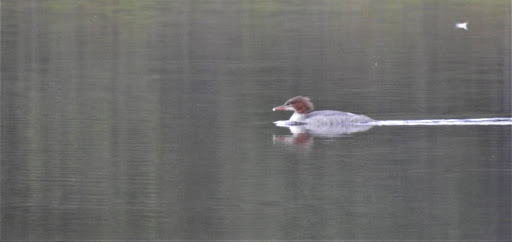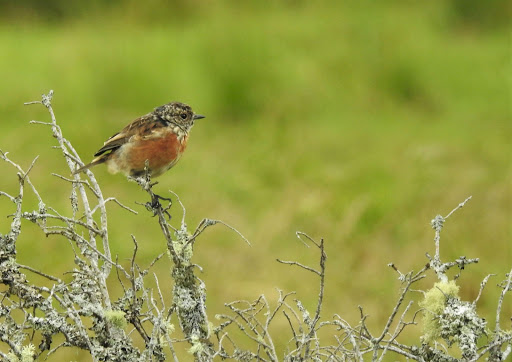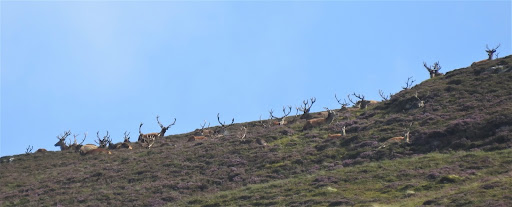August 2020 saw high pressure largely dominant in this area, meaning a generally warm, dry and sunny month , with just the last third having a few more showery, windy days. The clear skies did mean a few chilly dawn starts though, with temperatures ranging from just 4c early on up to a scorching (for up here!) 26c by early afternoon on a few occasions, and some of the showers late in the month were pretty heavy, so a layered approach to clothing and a cagoule on stand-by is recommended..
The days are noticeably shortening now as autumn approaches, but we still have 14-15 hours of usable daylight this far north, with dawn at around 5:30am and dusk at around 8:30pm...
With many of our summer visiting bird species departing here for their wintering areas from mid month, it was inevitable that local full-day bird lists would reduce down into the 30's or low 40's though this could be increased considerably if you included a visit to the Moray coast.
Mammal day lists varied between 3 and 8 species, with earlier starts generally proving more successful, especially for the shyer, more crepuscular species.
August is often a good month for Butterflies, dragonflies and day-flying moths in this area, and a good variety of species were seen on the calmer, sunnier days, though sightings tailed-off noticeably later in the month...
The Highland scenery is extremely picturesque now, with the heather at it's beautiful purple best, one or two ferns turning coppery gold, a few leaves beginning to morph into their autumn hues, lots of varieties of fungus appearing, and the Rowan trees now fully laden with bright red berries.
Local speciality and upland bird species seen regularly throughout the month included:
Osprey, Slavonian Grebe, Goldeneye and Dipper.
We also enjoyed some good views of Red-Throated Diver and Black-Throated Diver early in the month, though they became less frequent later on, a few reasonable sightings of Crested Tit and Crossbill, and we also started to see young birds of prey on the wing, including sightings of both Golden Eagle and White-Tailed Eagle...
Sadly, but not unusually, we failed to see Capercaillie or Black Grouse at all this month....
Mammals seen regularly locally during the month included: Red Squirrel, Rabbit, Brown Hare, Roe Deer, Red Deer, Reindeer and Mountain Goat, with just a couple of glimpses of Bank Vole, and one quick flash of a Stoat chasing Rabbits....
 |
The purple heather at it's beautiful best on a local upland moor
|
To give you an idea of what you may realistically hope to see if you are planning a future August visit, I hope the following more detailed information, illustrated with photos taken at sites in and around the Cairngorms National Park by myself, my friends or my safari clients this month and in previous August's, will help...clicking on the picture enlarges it to full-screen.
August 2020 bird sightings in more detail:
 |
Juvenile Ospreys - one eating a fish, one wishing he was!
|
 |
Juvenile Osprey
|
 |
Osprey with fish by Gaurang Purohit (photo taken from a hide)
|
Osprey was most frequently voted as 'bird of the day' by my safari clients this month, understandable I guess when you consider that these impressively large and attractively marked raptors can also provide additional "wow" factor when seen plunge-diving, eating or carrying fish!... and although the parent birds appeared to have departed by about the 25th, the now fully independent youngsters could occasionally be seen near the nest site right up to the end of the month....
 |
Young Red Grouse
|
 |
Red Grouse in the purple heather by Ashleigh Turner
|
 |
Red Grouse close-up by Gaurang Purohit
|
Red Grouse, still in family groups, continued to show well on our local heather moorlands, and similarly to the last couple of years, with brood sizes being smaller than normal and the youngsters slow to reach adult size, we had the bonus of the start of the shooting season being delayed , or even shooting being cancelled altogether on some estates...
 |
Feeding time for a newly hatched Slavonian (Horned) Grebe chick
|
 |
Adult and juvenile Slavonian (Horned) Grebe
|
Our small numbers of the very rare Slavonian (Horned) Grebes have usually departed for the coast by late July, but fortunately for us, having had a (very rare) second brood this year, following the loss of their first brood to a predator, they hung around throughout the month, and it was great to see all 3 chicks growing well and even fishing independently , a nice little August bonus this year...
 |
Goldeneyes
|
Our local Goldeneyes seem to have no problems breeding in this area, the only place in the UK where they do so, and it was good to see them still in large family groups on local lochs and rivers, all fishing together throughout the month..
 |
Adult and juvenile Black-Throated Diver
|
Still on the lochs, as I reported previously, Red-Throated Diver and Black-Throated Diver both bred successfully locally this summer, and although sightings reduced a little and became less predictable as the juveniles became more mobile, we still saw them reasonably regularly until late in the month, when they presumably departed for the coast, where they will stay until next spring....
 |
Crested Tit by Gaurang Purohit
|
Crested Tits have now joined the 'mixed winter flocks' of many different bird species 'working' through our local Caledonian pine forests... so... to see the 'Wee Cresties' you first have to find one of these roving flocks , then listen out for their distinctive chuckling trill , then try and pick them out as they move in annoyingly flitty style through the branches - not an easy task! , but, satisfyingly for myself as a guide, we managed it on a good number of occasions, with many of my safari clients obtaining a difficult and much sought after 'life-tick'... and on the cooler mornings there were even a few reports (and photos) of one or two visiting peanut feeders for the first time since late winter.......
 |
Male Crossbill
|
 |
Female Crossbill
|
Still in the forests, with the exception of one prolonged sighting on the 27th, and a couple of other reasonable but sadly all too brief views through my spotting scope, Crossbills sightings were (again!) usually of the rather frustrating 'fly-over' variety, with them only being identified by their characteristic 'jip' 'jip' calls as they flew overhead between different areas of the forests...and we only managed a couple of photo opportunities this month...
 |
Dipper
|
On the local rivers, sightings of Dippers were a little 'random', as the adults presumably show the youngsters around their territory, so I would recommend familiarizing yourself with their distinctive 'zit zit' calls to give you more chance of spotting them...
 |
Red Kite
|
 |
Common Buzzard
|
 |
A very rare photo of a perched Golden Eagle (juvenile)
|
Birds of prey are always popular with my safari clients, and sightings definitely increased this month, with visits to favourite local glens and moors produced regular encounters with Kestrel, Common Buzzard, Red Kite, Sparrowhawk and Peregrine Falcon, often in family groups, with a few views of Golden Eagle, a couple of White-Tailed Eagle, a solitary glimpse of both Goshawk and Hen Harrier, and a rare raptor this far north, a Hobby....
Other good birds seen/reported locally this month included:
 |
Whinchat
|
 |
Goosander
|
 |
Spotted Flycatcher
|
Whinchat, Spotted Flycatcher, Bullfinch, Short-Eared Owl, Whooper Swan, Goosander, Pink-Footed Goose and Barnacle Goose....
A few photos of more common birds seen locally this month:
 |
Song Thrushes
|
 |
Stonechat (juvenile)
|
 |
Grey Wagtail (juvenile)
|
 |
Wren by Gaurang Purohit
|
 |
Treecreeper by Gaurang Purohit
|
 |
Great Spotted Woodpecker by Gaurang Purohit
|
 |
Swallow by Gaurang Purohit
|
 |
Early morning at a picturesque local loch
|
August 2020 mammal sightings in more detail:
With bird sightings 'slowing down' a little, mammal sightings always become more important at this time of year, and we are fortunate to have such a good selection to go for in this area....
 |
Red Squirrel by Gaurang Purohit
|
 |
Red Squirrel by Gaurang Purohit
|
We are fortunate to have Red Squirrels in our local forests, a species sadly absent from most of the UK now, due largely to invasion by the introduced Grey Squirrel (and the Squirrel pox virus they carry), so they are always popular with my safari clients - often getting voted as 'mammal of the day', and forest walks and visits to my favourite Caledonian pine forest feeding stations produced lots of good sightings, often with decent photographic opportunities...though we did have a few days when none showed at all...
 |
Red Deer hinds
|
 |
Red Deer stags
|
A frequent winner of my safari clients 'mammal of the day' award is the iconic @monarch of the glen' - the Red Deer, and although they can be seen in more places all round the UK these days, it is still great to see them in their 'proper' home environment of upland glens and mountainsides....and although they are mainly still in their large same-sex groups at the moment, that will be sure to change in a few weeks time....
 |
Feral Mountain Goats by Gaurang Purohit
|
Still up in the glens,we also have feral Mountain Goats, interesting animals that come in a wide variety of colours from white, through grey and brown to black, or any combination of some or all of these colours, and many of my safari clients saw them in the wild for the first time whilst out on safari with me this month...
 |
A typical view of a Roe Deer by Gaurang Purohit
|
Roe Deer are actually fairly common throughout most of the UK, but due to their crepuscular nature, most of my safari clients rarely see them, and they are easily disturbed by human noise and activity...but July and August is their 'rutting' time, and early starts, and quiet drives and walks round secluded areas gave us a few decent views this month..
Being largely nocturnal, and with their summer coat perfectly matching their upland surroundings, Mountain Hares can prove very difficult to see in the summer months, and so it proved this month, with just a couple of brief glimpses on early-morning visits to upland moorlands...
 |
Brown Hare (photo from August 2019)
|
Thankfully, our local Brown Hares were a little more obliging, especially early in the morning, though they rarely stick around once they become aware of us watching them, so it's rare to get a decent photo opportunity...
Rare/nocturnal mammals:
I get a few enquiries about the possibility of seeing Badgers and Pine Marten from my safari clients, many of whom I suspect are unaware that they are actually a largely nocturnal creature, and although we do get the occasional (maybe one or two a year) dawn glimpse of one, you would definitely have a much higher chance of seeing them at a specific dusk Badger/Pine Marten watching hide - Please contact me for more information.
Similarly, our inland Otters too are mainly active during the hours of darkness, and again, although we do get a few early-morning sightings on local lochs and rivers each year, looking for them feeding in a suitably quiet, kelp - filled bay on the coast on a rising tide, but at any time of day, would give you a much better chance.
Whilst we are still on the 'tricky to see stuff', the Scottish Wildcat too, as well as being incredibly rare now, is also generally nocturnal, and the fact that I have had a mere handful of (dawn or dusk) sightings in 16 years of providing wildlife safaris should give you an idea of how difficult they are to see.
 |
A local upland river, sparkling in the late summer sun
|
Other wildlife:
 |
Scotch Argus
|
 |
Scotch Argus by Gaurang Purohit
|
 |
Small Tortoiseshell
|
Alongside a few lingering individuals of the more common species, we seemed to have an 'explosion' of our local speciality butterfly - the Scotch Argus early in the month, when the weather was warm and dry, with some sites having unusually high numbers. It was short-lived however, as the colder windier weather later in the month saw them all promptly 'disappear' again....
 |
Leaping Atlantic Salmon
|
The Atlantic Salmon are now making their way further up our local rivers, and visits to popular local falls and 'leaps' can give great views - and for those with LOTS of patience, even the odd photo opportunity, as these amazing creatures attempted to fight the powerful flows and often steep ascents, to return upstream to their birthplace breeding grounds to reproduce...a highly recommended wildlife experience....
 |
Late summer in a favourite local upland glen
|
News:
The Scottish Highlands has had very few COVID-19 cases in comparison to most of the UK, and on my safaris we tend to visit remote , wild habitats well away from the more popular tourist areas, and usually have very little interaction with other people, and this is something that I intend to continue.
I can advise that I have not had COVID-19, have no symptoms, and have not knowingly been in contact with anyone who has.
I re-commenced providing my wildlife safaris from 15th July 2020, subject to the following conditions/changes:
1) Parties will be limited to pre-booked small, preferably connected groups - so no mixing of unconnected parties unless we can do it safely and legally.
2) There will additional COVID-19 related health questions asked at the time of booking.
3) My safari vehicle will be deep cleaned before and after each safari.
4) We will use the middle and rear rows of seats in my vehicle (a spacious Land Rover Discovery 7-seater) in preference to the front passenger seat where possible.
5) Any parties uncomfortable with travelling in my vehicle will have the option to follow me in their own vehicles.
6) Whilst on board my safari vehicle your guide and all clients will be required to wear face coverings.
7) We will adhere to Government social distancing recommendations where possible.
8) All surfaces/equipment touched frequently will be cleaned regularly by your guide.
9) Hand sanitizer will be provided for guide and client use.
10) Clients will be asked to bring their own optical equipment where possible - any loaned/communal equipment will be cleaned regularly.
11) Clients will be asked to provide their own food/drink as we cannot do so at present.
12) Public toilets will be used where possible, with the option to return to client accommodation for comfort stops if required, and 'bush-toilets' only being used as a last resort.
13) If first aid is required, I may need to ask other members of the party to assist.
14) I will require all clients to complete a COVID-19 disclaimer/ infection declaration form.
15) A Health and Safety Executive risk assessment form has been completed and will be displayed in my vehicle..
If you have any questions/queries, please feel free to contact me.
Summary:
So, although maybe not a favourite month for the hard-core birder, twitcher' or photographer to visit, August in the Cairngorms National Park would still appear to have quite a lot to offer the more casual beginner or 'improver' nature-watcher, or maybe those with a young family looking for a less intense or 'taster' wildlife safari experience, with no need for a really early start, in arguably, one of the more scenic months of the year.
Looking back through my notes and photos for this month, I reckon that our sightings were actually pretty good for the time of year, and more importantly, my safari clients certainly seemed to enjoy themselves...
 |
Ancient Caledonian pine forest
|
Reviews:
I know a lot of visitors to this area very wisely check out reviews of attractions/experiences at Tripadvisor before 'taking the plunge' and booking - if you wish, you can check out my clients comments at the link below....
https://www.tripadvisor.co.uk/Attraction_Review-g186537-d3335134-Reviews-
Highland_Wildlife_Birdwatch_Safaris-Aviemore_Aviemore_and_the_Cairngorms_Scottish.html
If you think you know someone who may enjoy a taste of what I do, why not treat them to a safari gift
certificate? They make a thoughtful and imaginative present, are available for any amount and are valid at any time within a year from the date of purchase....




















No comments:
Post a Comment